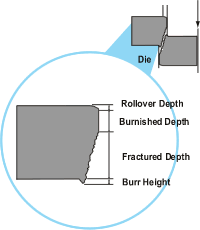In the world of metal stamping, burrs and sharp edges are often interchangeable.
Whenever sheet metal is cut the characteristics of the cut edges are the same. They will exhibit a roll-over, cut band, a break band and a burr. There are tooling techniques that can eliminate the burr, but for now let’s set that aside.
Cutting action takes place in three stages as the punch or cutting-edge moves through the material: 1) initial plastic deformation, 2) penetration, and 3) fracture. During initial plastic deformation, the “edge radius” or “roll-over” is formed. During penetration, the “cut band” or “burnish” is created. During fracture, the break is created and a burr is developed. A normal anticipated burr produced with a sharp tool will be up to 10% of the material thickness and will be sharp. For example, .100 thick material = .010 burr.
When a part print has a note stating, “no burrs or sharp edges”, in a pure sense this isn’t possible without post processing and added cost. Is that really the designers’ intent or do they really mean no extreme burrs? Often designers get nervous discussing their intent because they do not want any assemblers to get cut…and it’s hard for us to quantify what the exact result will be.
Our goal is to thoroughly discuss every inch of your part pre-production so that all parties involved understand the expected results and costs involved with removing stamping burrs.
